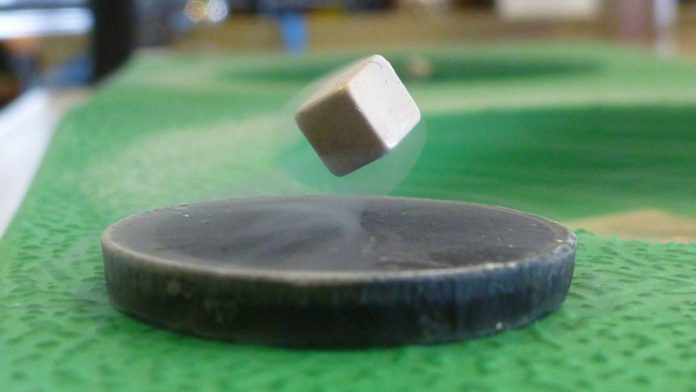Quantum superconductors are fascinating. They behave unlike most materials that we come in contact with in our daily lives, and we are only now starting to scratch the surface of how to create and control them. We are used to a world of conductors: our wires carry electricity, but they are not efficient – their resistance causes them to lose energy, primarily by producing heat. On the other hand, at extreme temperatures and pressure, quantum superconductors have zero resistance to electrical current. This makes them useful for a huge number of electronic applications, from faster and more efficient devices to levitating magnetic trains.
Let’s start with a short lesson on electromagnetism.
Most objects that we think of as being magnetic are items that attract other materials that can be magnetized – such as a fridge magnet picking up a nail, or stuck to the side of a fridge. This inherent property of magnetic materials is called ferromagnetism.
By contrast, electromagnetism is caused by the flow of electric current. As electric current moves through a coil or wire, it generates a magnetic field along the length of the coil.
In fact, electricity and magnetism exist on a spectrum, where electric fields can produce magnetic effects, and magnets can produce electric currents.
This brings us to a simple electric train experiment, using a coil of bare copper wire, a pair of rare earth magnets, and a battery. This video by AmazingScience shows electromagnetism in action.
When the train is in contact with the coils, the magnets conduct electricity from the battery through the wires. Once the current is moving, it sets up an electromagnetic field around the train. The magnets, arranged so that the north poles of the magnets face away from one another (would repel one another if brought together), push the train from one end and pull the train from the other end, through the magnetic field and along the track.
There are great diagrams and tips for how to repeat the experiment here. (Yes, I have not only tried this at home, but my sister baked it into a birthday cake for my nephew. Just try to keep the track away from anything that can be magnetized, including the kitchen sink.)
In the video below from the Royal Institute, we see that a strong magnet moving through a thick copper pipe (conductor) can induce an electric current, which in turn sets up its own electromagnetic field, slowing down the magnet as it falls through the pipe. The inefficiency of the conductive copper means that the electromagnetic field dies away over time, and the magnet cannot levitate because its motion is what is setting up the field.
Replacing the copper with a piece of yttrium barium copper oxide, which becomes a superconductor when cooled by liquid nitrogen, the magnet and the superconductor can be locked into position; the superconductor has no resistance, and so their electromagnetic interaction allows the pair stay a fixed distance apart for as long as the superconductor stays cooled – as the superconductor tries to fall towards the track by gravity, the magnets induce a current that sets up an electromagnetic field that pushes it back away. The opposite is true as the superconductor tries to fall away from the track. The result? Levitation both above and below the track! Along the track, the magnetic field is constant, so the superconductor can be pushed along its length.
To learn more about the quantum world, check out our feature video and interview with R2R rockstar Prof. Andrea Damascelli.





































